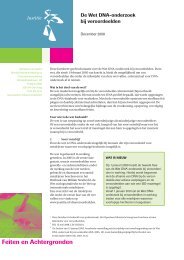INTERPOL HANDBOOK ON DNA DATA EXCHANGE AND PRACTICE
INTERPOL HANDBOOK ON DNA DATA EXCHANGE AND PRACTICE
INTERPOL HANDBOOK ON DNA DATA EXCHANGE AND PRACTICE
Create successful ePaper yourself
Turn your PDF publications into a flip-book with our unique Google optimized e-Paper software.
<strong>DNA</strong> SAMPLING<strong>AND</strong> EVIDENCE COLLECTI<strong>ON</strong>The most important aspect of evidence collection and preservation is protecting thecrime scene from the time the first officer or responder arrives until the last piece ofevidence has been noted and collected. This section will cover the procedures for thefirst responder to a crime scene, preservation of the scene, actions of the Crime SceneInvestigator (CSI), valuable kits to process <strong>DNA</strong> evidence, the collection of evidenceand anti-contamination guidelines. The administration and transportation requirements of<strong>DNA</strong> evidence are also addressed.All biological evidence is subject to deterioration. Careful collection and storage willensure that this evidence is preserved so that useful information can be obtained from itsanalysis. Most <strong>DNA</strong> typing methods are robust; however, dirt, grease, some dyes in fabrics,and other substances can seriously compromise the <strong>DNA</strong> typing process.The advice given applies to the investigation of all crimes where body fluids are deposited,such as sexual offences, robberies, burglaries, etc. A crime scene log or sign-in sheet shouldbe used to record who enters the area and the time of entry and exit. In addition, all crimescene personnel must wear protective clothing, hairnets, gloves, paper boots, and masks.Because of the ease with which <strong>DNA</strong> contamination can occur, the first police officershould meticulously record the identity and actions of those who have already been tothe scene and anyone else who may pose a post-incident contamination risk.•first respondersTaking the Initial CallThe actions of the cleaning supervisor and first responding officer in the scenarioclearly demonstrate the actions that should be taken to efficiently preserve the scene.The scene should be secured as soon as possible so that only the people responsiblefor the crime investigation have access. Any other individuals or unescorted personnelcan introduce contamination and disrupt the crime scene. The area can be securedusing ropes, tape, cones, barricades, or even additional officers. The administration andtransportation requirements are also addressed.<strong>DNA</strong> SAMPLING<strong>AND</strong> EVIDENCE COLLECTI<strong>ON</strong>PAGE 19







